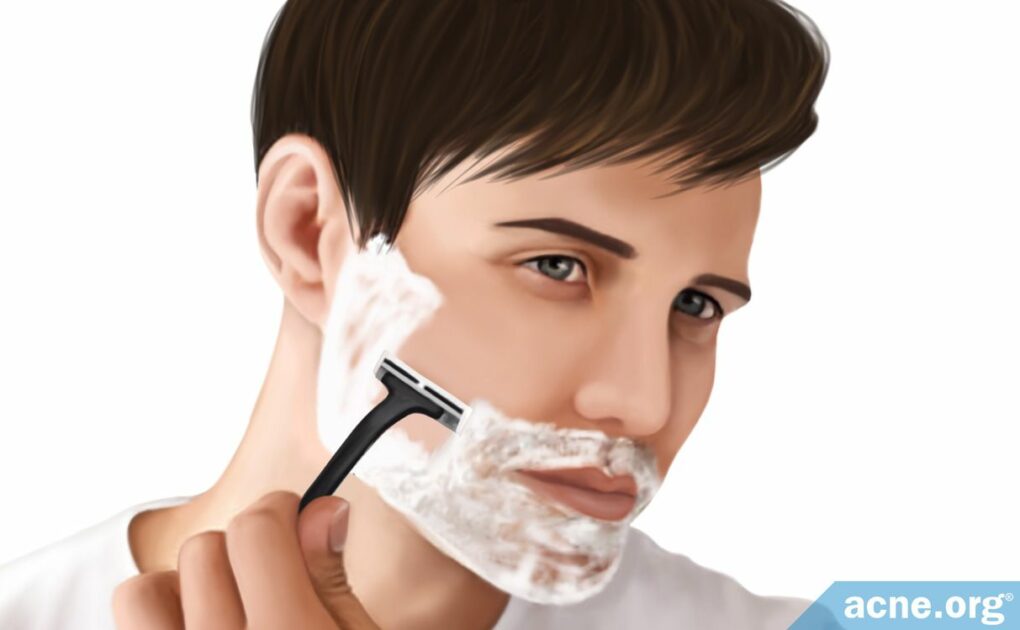A Gentle Shave Might Help, but Don’t Overdo It

The Essential Info
How Shaving May Help with Acne
- Shaving gently with a non-comedogenic (won’t clog pores) shaving cream/gel and a fresh, non-irritating blade razor might help to prevent acne by removing dead cells from the outer layer of skin, which can signal the skin to replace cells more quickly, helping to prevent pores from becoming clogged.
How Shaving Can Make Acne Worse
- Shaving with a comedogenic (clogs pores) shaving cream/gel can clog pores. Check this page for a list of ingredients to avoid in whichever shaving cream/gel you choose.
- Shaving with an old or irritating blade razor can lead to physical irritation of the skin. Anything that physically irritates the skin can lead to more acne.
- Shaving with an electric razor is far more irritating than a blade razor. Many people here on the acne.org team including myself have tried every electric razor we can get our hands on, and they are all irritating. Don’t be fooled by claims of “gentle to the skin” on electric razors. If I ever find an electric razor that is not overly irritating, I’ll be sure to let you know.
- How you shave also matters. Shaving in an overly-aggressive way can create skin irritation, which can lead to more acne. Stay confident yet gentle when you shave, and don’t go over any area too many times.
The Bottom Line: Gently, yet confidently shaving every day with a sharp, non-irritating blade razor (my favorites are the Gillette® TracII and the Gillette® Sensor Excel*) and a non-comedogenic shaving cream/gel should not be bad for acne, and may just prove to be beneficial.
Tip – Use Cleanser Instead of Shaving Cream/Gel: Not many people realize it, but cleansers can easily be used as shaving creams. I’ve been doing it for years myself and prefer it to most shaving creams. Using a gentle facial cleanser in place of shaving cream/gel is a safe way to avoid potentially pore-clogging ingredients in many shaving creams/gels.
*Acne.org is not associated with Gillette in any way.

The Science
- Potential Benefits of Shaving
- Potential Risks of Shaving
- Shaving Creams/Gels – Choose Wisely
- The Bottom Line
Shaving poses both potential benefits and risks for acne. When you shave your skin, you are removing hair, but also removing skin cells from the surface of the skin. This means you are not only shaving hair but also exfoliating the skin.
In order to understand how shaving affects acne, we need to first understand the process of exfoliation. Let’s jump in.
The Process of Exfoliation
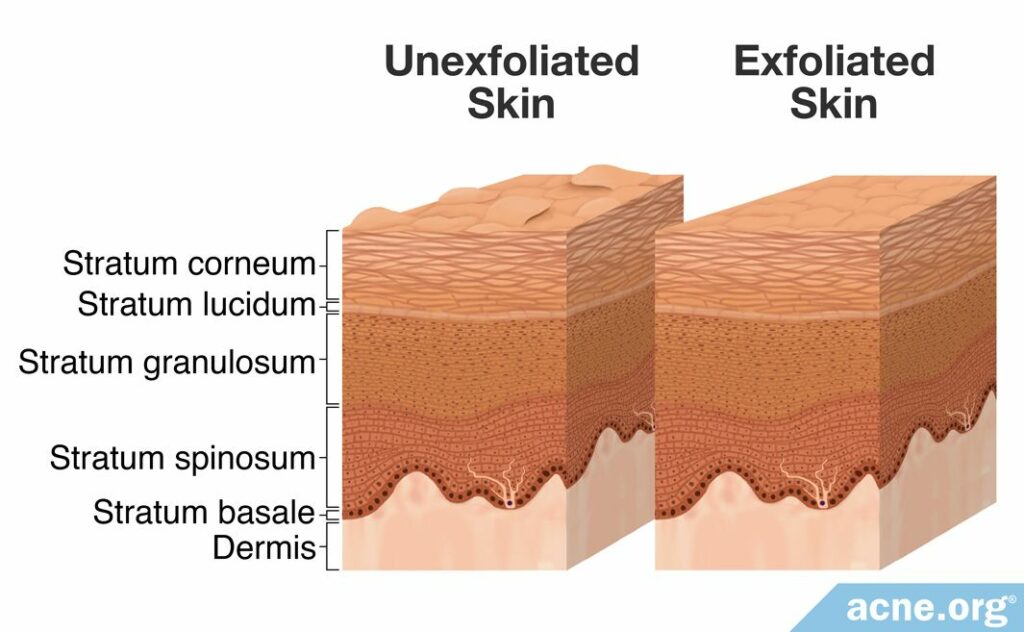
The word exfoliation comes from the Latin exfoliare, which means “to strip off leaves.” For the skin, it means to strip dead cells from its outermost layer. This outermost layer of the skin is called the stratum corneum, and the dead cells of this layer that are stripped off are called corneocytes.
Skin exfoliation is always happening and occurs naturally as the skin renews itself, but cosmetic procedures like shaving can speed up the process.
When exfoliation happens naturally, it is slow because only a few corneocytes peel off at a time. Shaving speeds up this process by removing a greater number of cells, which in turn alerts the skin underneath to speed up the replacement of skin cells.
When shaving is done in a non-irritating way, it can be beneficial for keeping pores from becoming clogged. On the other hand, if you shave in an irritating way, this can trigger more acne.
When done correctly, exfoliation:
- Improves skin texture by making it smoother
- Evens out skin tone
- Slows signs of aging1
- Helps to prevent clogged pores2-4
Exfoliation can be either:
- Mechanical (includes shaving): Mechanical exfoliation involves physically removing skin cells by various methods, including shaving, or by rubbing the skin with abrasive material such as a washcloth, crushed apricot seeds, brushes, or sponges.
- Chemical: Chemical exfoliation involves applying an acid to the skin that loosens and removes skin cells chemically. Chemical exfoliation is normally preferable to mechanical exfoliation because it is less irritating.
However, even though chemical exfoliation is normally preferable, gently shaving with a sharp, non-irritating blade razor can be an exception to this rule and can provide mechanical exfoliation without irritation.
Potential Benefits of Shaving
There are no controlled scientific studies that demonstrate the effects of shaving on acne. However, shaving removes dead skin cells from the skin, and this may signal the skin to speed up the production of skin cells, thus increasing skin cell turnover and helping to prevent pores from clogging. Clogged pores is the first step in acne, so anything that prevents or reduces them helps with acne. However, remember this is only the case if shaving is done gently and without much irritation. Irritating the skin leads to more acne.
Note: Any exfoliation benefits of shaving come from shaving with a razor blade that glides across the skin and does not include electric shaving in which blades are separated from the skin by a foil.5
Potential Risks of Shaving
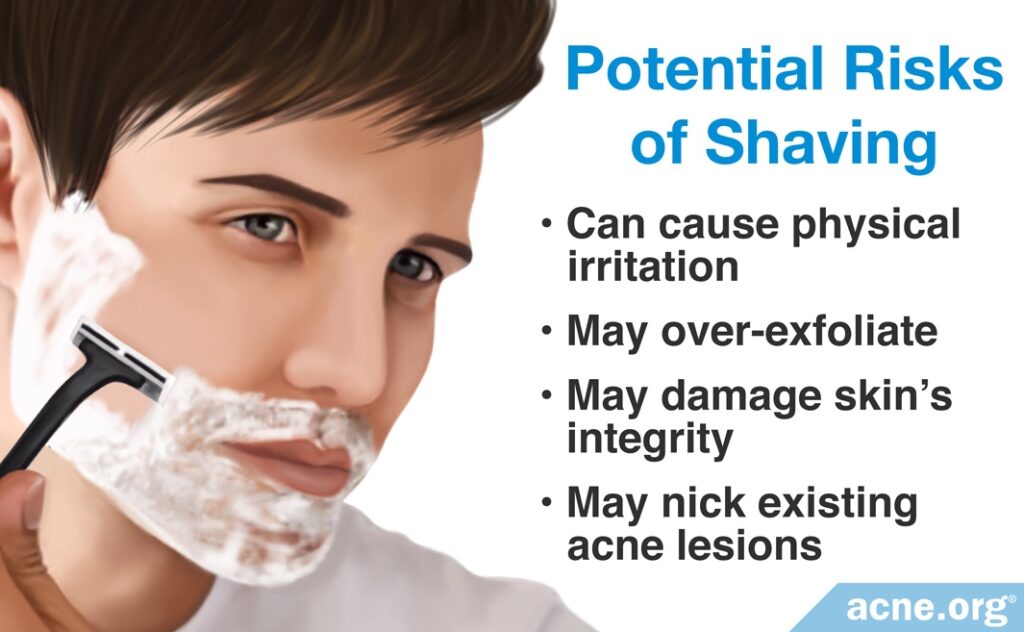
Skin irritation
While there are reasons to believe shaving might be beneficial for acne, we should still be cautious. Vigorous shaving, shaving with a dull blade, or shaving with the wrong razor can cause physical irritation. The last thing anyone with acne wants is to increase skin irritation. Skin irritation is well known to lead to more acne.
Also, “over-shaving,” which refers to shaving over an area too many times or pressing too hard with the razor can removing too many cells and damage the integrity of the skin, which is tantamount to skin irritation.3,6
In short, to lessen the risks of shaving, stay gentle, don’t go over any area too many times, and use a fresh and sharp razor.
Expand to read more about the science of physical irritation
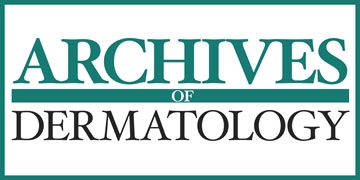
The researchers, Mills and Kligman, established this connection in a 1975 study published in the journal, Archives of Dermatology. They performed experiments showing that physical irritation aggravated the symptoms of acne in seven of ten study-subjects. To emphasize the importance of physical irritation as a cause of acne, they introduced the term, acne mechanica.7
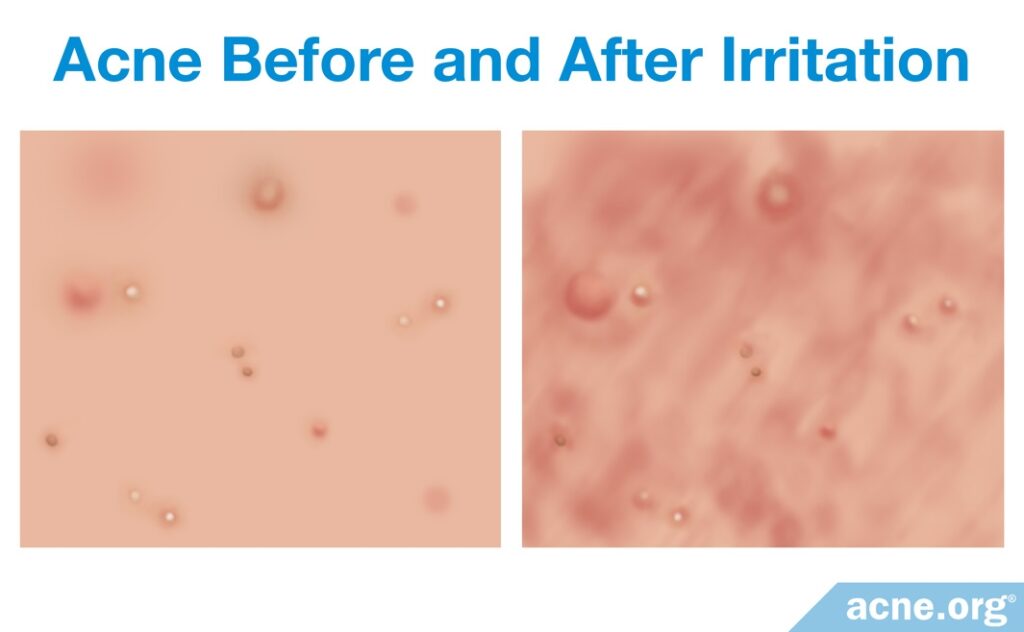
Irritation of the skin is a common side effect of shaving, including electric shaving, and is a frequent complaint from men in the United States and in Europe, as we can see in more recent studies.2,8-10 This reinforces the need to reduce irritation when shaving acne-prone areas.

A study published in 2015 in the International Journal of Bioassays reported that 41% of men who had sensitive skin reported skin reactions after shaving. The most common reactions were redness, burning, and stinging.2
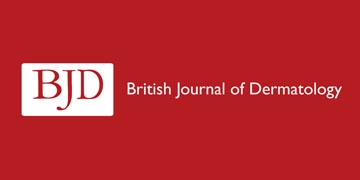
A 2012 study published in the British Journal of Dermatology showed a similar connection between shaving and irritation: men reported that the neck was the area where they most likely were to experience irritation due to shaving. The symptoms included redness, cuts, burning, stinging, tightness, dryness, and itching.8
Scientists believe that the neck may be particularly prone to irritation because the hair in this area is angled close to the skin and grows in different directions, requiring a close shave and multiple passes with the razor.9

A study in 2007 made a connection between acne mechanica and shaving. This study, published in the International Journal of Dermatology, surveyed men who possessed a serious form of acne called acne keloidalis nuchae (AKN). AKN is a chronic condition in which hair follicles on the back of the neck become inflamed and form fibrous plaques (scaly, red, bumpy areas) and papules. Ninety percent of the men believed that their AKN started with a haircut at a barbershop. The authors of the study noted that barbers commonly use electric razors during haircuts and observed, “These instruments have a sharp edge when new and can easily traumatize the skin of the nape of the neck. With continuous use, the cutting edge becomes dull and blunt and, in an attempt to obtain as close a [haircut] as possible, force is applied, leading to further trauma to the skin.”10
Razor bumps
Apart from irritating the skin and potentially triggering acne, shaving can also cause another condition that resembles acne: razor bumps or, in medical terms, pseudofolliculitis barbae.
Razor bumps occur when shaved hairs get trapped inside the skin and cause acne-like lesions. Like acne, pseudofolliculitis barbae involves inflammation and can cause dark spots that may linger after the razor bumps themselves have healed.
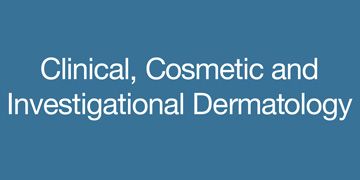
An article published in the journal Clinical, Cosmetic and Investigational Dermatology in 2019 described pseudofolliculitis barbae as follows: “It is commonly seen in the beard area…It occurs more frequently in those with tight curly hair, especially in men of African and, to a lesser extent, those of Asian descent…the shaving of terminal hair usually triggers it.”11
If you are prone to razor bumps, the best thing to do is to stop shaving altogether. However, you can also reduce your chances of developing razor bumps by using a 1- or 2-blade razor and shaving in the direction of hair growth. Avoid stretching the skin while you shave, as this increases the likelihood of razor bumps.
Weakening skin barrier function
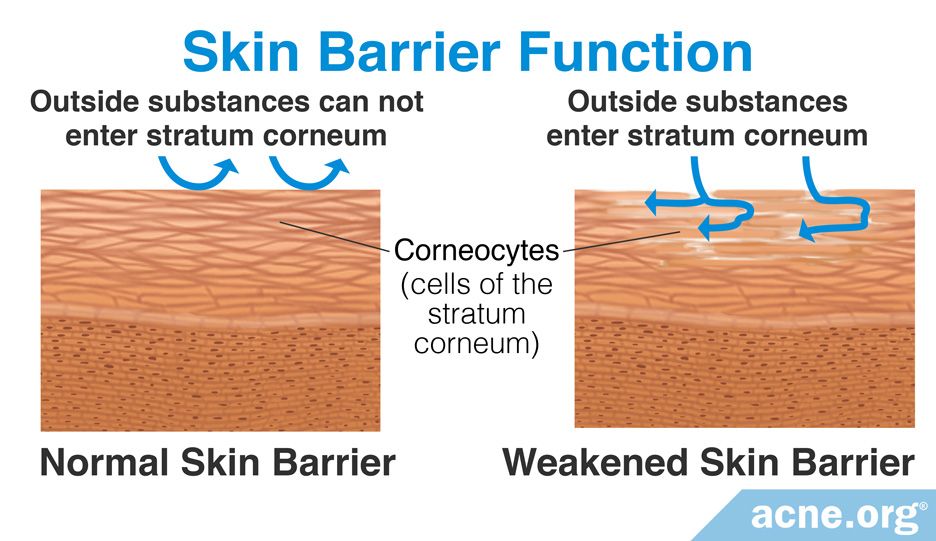
The top layer of our skin provides us with what is referred to as the skin barrier function. The skin barrier function keeps water in our skin and protects its deeper layers from harmful chemicals in the environment. Shaving in an irritating way can damage the skin’s barrier, allowing water to escape and chemical irritants to penetrate the skin more easily. This is important because acne sufferers tend to experience an impaired skin barrier function. Therefore, for acne-prone people, it becomes even more important to not further weaken this already impaired barrier.
Alcohol-based aftershave lotions may contribute to the problem because alcohol can dehydrate the skin and enhance penetration of other chemicals into the skin.4
For people with acne, it is important to keep the skin barrier function as intact as possible. This means shaving gently with a non-irritating shaving cream and razor and avoiding alcohol-based aftershave lotions.
Nicking existing acne
Shaving, especially with the wrong type of razor, can be difficult if you have active acne lesions in your bearded area. Shaving can nick or cut existing or burgeoning acne lesions, causing further damage to the skin and greater risk of scarring.
Electric razors
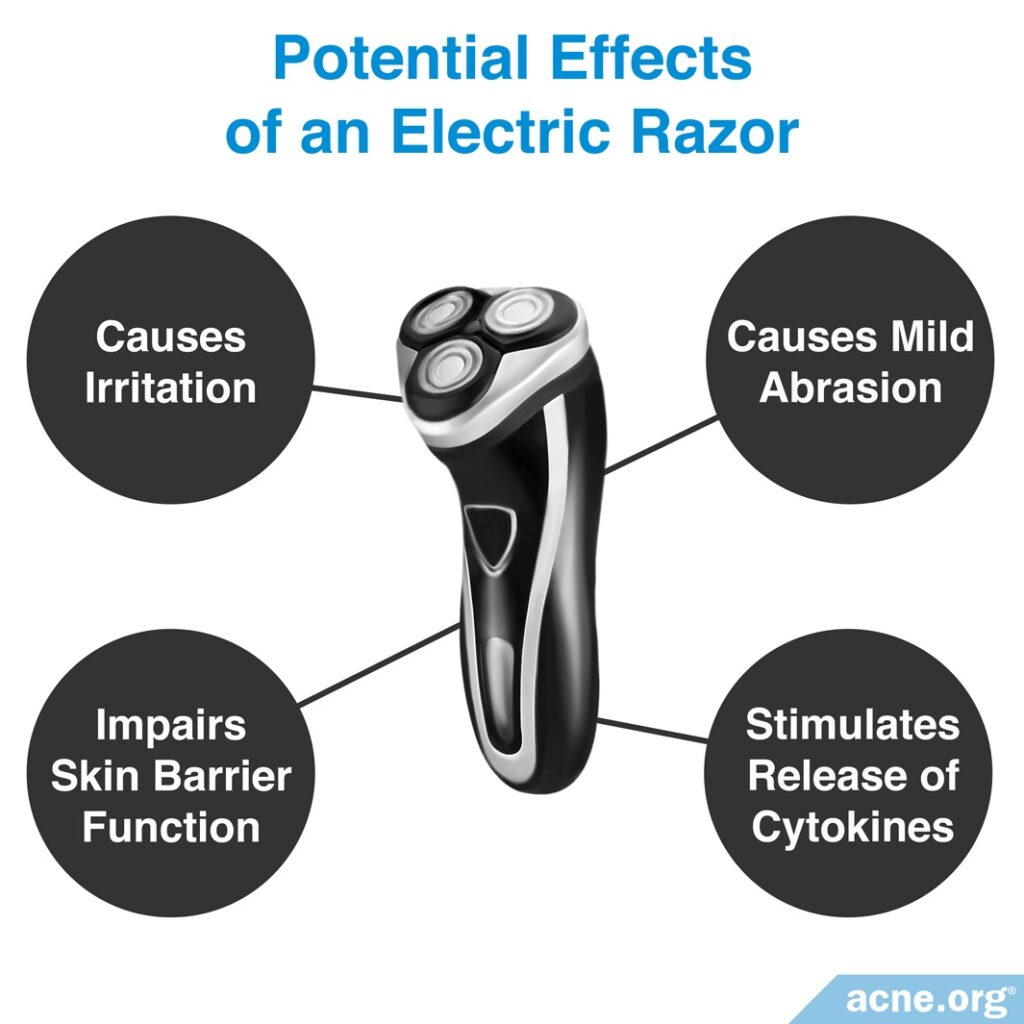
Electric shavers tend to cause irritation by pressing skin into tiny holes in the shaving foil, resulting in mild abrasion of the outer skin.3 This abrasion stimulates the nerve endings in the skin and activates the release of inflammatory molecules called cytokines. Acne is an inflammatory disease, so anything that produces cytokines and causes inflammation should be met with caution. Researchers believe that cytokines induce the burning and itching sensations that occur after shaving with electric razors.12 To keep acne in check, for most people this means avoiding electric razors altogether.
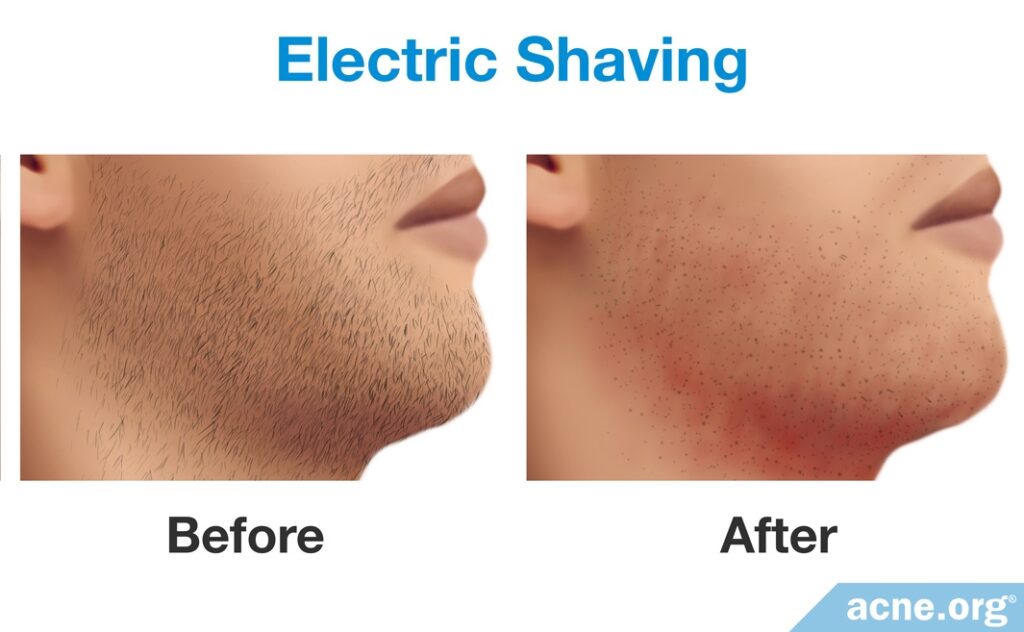
Shaving Creams/Gels – Choose Wisely
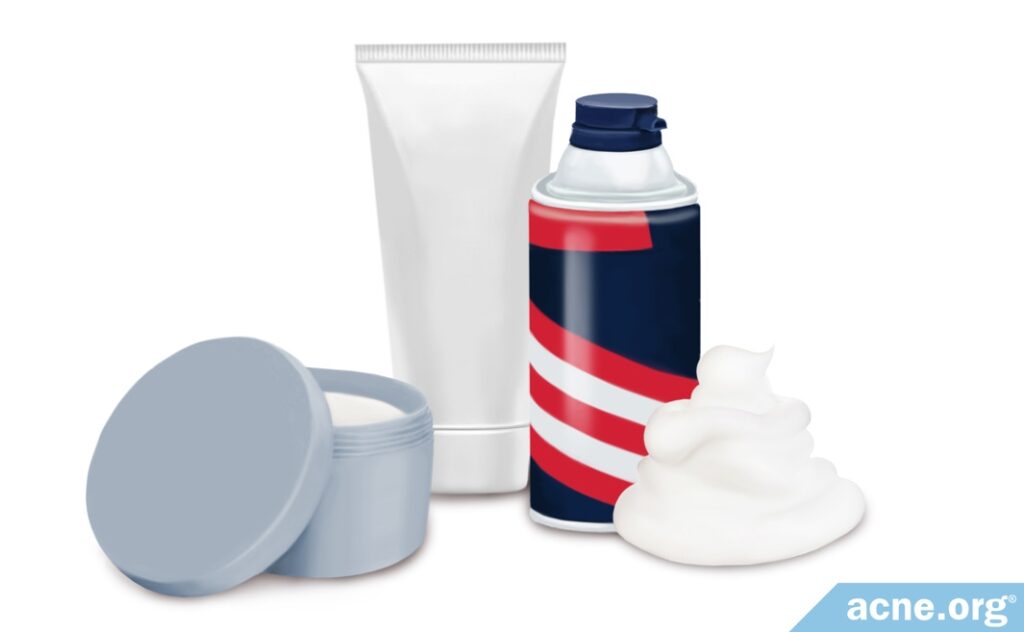
Products applied to the skin before shaving can be comedogenic (pore-clogging), and clogged pores are the first step toward acne lesions.
In the mid 1940s, French dermatologists first studied the problem of skincare products causing acne. Since that time dermatologists have performed studies to determine which skincare product ingredients might clog pores.
For instance, stearic acid, an ingredient used in almost every shaving cream and gel on the market, may be moderately comedogenic. Coconut oil is another common ingredient in cosmetic shaving products that is known to clog pores.
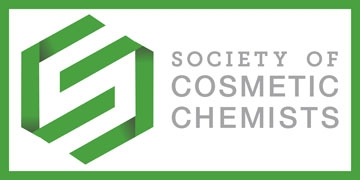
Both stearic acid and coconut oil were among more than 200 ingredients tested in a 1989 study published in the Journal of the Society of Cosmetic Chemists. The intensity of pore-clogging was measured on a scale of 0 to 5. Stearic acid scored a 2-3, depending on the source material. Coconut oil rated 4, indicating severe pore-clogging. Other ingredients sometimes used in shaving creams and gels also came back with high ratings. You can see them here.13
When researchers tested stearic acid and coconut oil, they did so at 10% strength. In the real world, manufacturers use these ingredients at various percentages, sometimes low percentages, in shaving creams and gels. Unfortunately, the testing does not tell us what levels of these ingredients are safe. To complicate matters further, the study was performed by applying substances to the inner ear of rabbits. The rabbit ear is more sensitive than human skin, so the effects might not be the same.14 There is no research currently available that studies specifically the pore-clogging effects of finished shaving products themselves, but to be safe, aim to avoid stearic acid in your shaving cream or gel, and most definitely avoid coconut oil.
A great alternative to shaving creams and gels is simply a gentle facial cleanser. Most facial cleansers contain ingredients called surfactants that provide the slip that you need to shave, and they usually do not contain stearic acid or coconut oil.
The Bottom Line
Don’t be scared about shaving if you have acne. When done in the right way, shaving with a sharp, non-irritating razor and a non-comedogenic shaving cream or gel (or gentle facial cleanser), can exfoliate the skin, which may lead to fewer clogged pores. Don’t expect shaving to clear your skin, but also don’t expect it to break you out if you do it the right way.
References
- DeHaven, C. Mechanisms of exfoliation. https://www.isclinical.com/media/WhitePapers/pdf/WhitePaper_MechanismsOfExfoliation_Jan2015_1_.pdf
- Debbarma, D. et al. Clinical review of deep cleansing apricot scrub: An herbal formulation. Int. J. Bioassays 4.9, 4251 – 4253 (2015). https://www.ijbio.com/abstract/clinical-review-of-deep-cleansing-apricot-scrub-an-herbal-formulation-14069.html
- Capretto, L. 3 Subtle signs you’re over-exfoliating your skin. The Huffington Post (2015). https://www.huffpost.com/entry/signs-youre-over-exfoliating_n_56019a36e4b00310edf8c802
- Kubba, R. et al. Cosmetics and skin care in acne. Indian J. Dermatol. Venereol. Leprol. 75, 55 – 56 (2009). http://www.ijdvl.com/article.asp?issn=0378-6323;year=2009;volume=75;issue=7;spage=55;epage=56;aulast=Kubba
- Exfoliation (cosmetology) https://en.wikipedia.org/wiki/Exfoliation_(cosmetology)
- Howard, D. When razor meets skin: A scientific approach to shaving http://www.dermalinstitute.com/us/library/16_article_When_Razor_Meets_Skin_A_Scientific_Approach_to_Shaving.html
- Mills, O. & Kligman, A. Acne mechanica. Arch. Dermatol. 111, 481 – 483 (1975). https://www.ncbi.nlm.nih.gov/pubmed/123732
- Cowley, K. & Vanoosthuyze, K. Insights into shaving and its impact on skin. Brit. J. Dermatol. 166, 6 – 12 (2012). https://www.ncbi.nlm.nih.gov/pubmed/22385029
- Cowley, K. & Vanoosthuyze, K. The biomechanics of blade shaving. Int. J. Cosmet. Sci. 38 Suppl 1, 17-23 (2016). https://www.ncbi.nlm.nih.gov/pubmed/27212467
- Salami, T. et al. Prevalence of acne keloidalis nuchae in Nigerians. Int. J. Dermatol. 46, 482 – 484 (2007). https://www.ncbi.nlm.nih.gov/pubmed/17472675
- Ogunbiyi A. Pseudofolliculitis barbae; current treatment options. Clin. Cosmet. Investig. Dermatol. 12, 241-247 (2019). https://www.ncbi.nlm.nih.gov/pubmed/31354326
- Rietzler, M. et al. Innovative approaches to avoid electric shaving-induced skin Irritation. Int. J. Cosmet. Sci. 38, 10 – 16 (2016). https://www.ncbi.nlm.nih.gov/pubmed/27212466
- Fulton, J. Comedogenicity and irritancy of commonly used ingredients in skin care products. J. Soc. Cosmet. Chem. 40, 321 – 333 (1989). http://www.nononsensecosmethic.org/wp-content/uploads/2013/12/Comedogenicity-and-irritacy-of-commonly-used-ingredients.pdf
- American Academy of Dermatology invitational symposium on comedogenicity. J. Am. Acad. Dermatol. 20, 272 – 277 (1989). https://www.ncbi.nlm.nih.gov/pubmed/2521642
 Acne.org Products
Acne.org Products